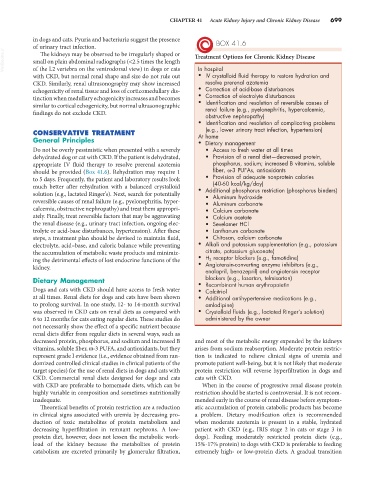Page 727 - Small Animal Internal Medicine, 6th Edition
P. 727
CHAPTER 41 Acute Kidney Injury and Chronic Kidney Disease 699
in dogs and cats. Pyuria and bacteriuria suggest the presence
of urinary tract infection. BOX 41.6
VetBooks.ir small on plain abdominal radiographs (<2.5 times the length Treatment Options for Chronic Kidney Disease
The kidneys may be observed to be irregularly shaped or
of the L2 vertebra on the ventrodorsal view) in dogs or cats
• IV crystalloid fluid therapy to restore hydration and
with CKD, but normal renal shape and size do not rule out In hospital
CKD. Similarly, renal ultrasonography may show increased resolve prerenal azotemia
echogenicity of renal tissue and loss of corticomedullary dis- • Correction of acid-base disturbances
tinction when medullary echogenicity increases and becomes • Correction of electrolyte disturbances
similar to cortical echogenicity, but normal ultrasonographic • Identification and resolution of reversible causes of
renal failure (e.g., pyelonephritis, hypercalcemia,
findings do not exclude CKD.
obstructive nephropathy)
• Identification and resolution of complicating problems
(e.g., lower urinary tract infection, hypertension)
CONSERVATIVE TREATMENT At home
General Principles • Dietary management
Do not be overly pessimistic when presented with a severely • Access to fresh water at all times
dehydrated dog or cat with CKD. If the patient is dehydrated, • Provision of a renal diet—decreased protein,
appropriate IV fluid therapy to resolve prerenal azotemia phosphorus, sodium; increased B vitamins, soluble
should be provided (Box 41.6). Rehydration may require 1 fiber, ω-3 PUFAs, antioxidants
to 5 days. Frequently, the patient and laboratory results look • Provision of adequate nonprotein calories
(40-60 kcal/kg/day)
much better after rehydration with a balanced crystalloid • Additional phosphorus restriction (phosphorus binders)
solution (e.g., lactated Ringer’s). Next, search for potentially • Aluminum hydroxide
reversible causes of renal failure (e.g., pyelonephritis, hyper- • Aluminum carbonate
calcemia, obstructive nephropathy) and treat them appropri- • Calcium carbonate
ately. Finally, treat reversible factors that may be aggravating • Calcium acetate
the renal disease (e.g., urinary tract infection, ongoing elec- • Sevelamer HCl
trolyte or acid-base disturbances, hypertension). After these • Lanthanum carbonate
steps, a treatment plan should be devised to maintain fluid, • Chitosan, calcium carbonate
electrolyte, acid–base, and caloric balance while preventing • Alkali and potassium supplementation (e.g., potassium
the accumulation of metabolic waste products and minimiz- citrate, potassium gluconate)
ing the detrimental effects of lost endocrine functions of the • H 2 receptor blockers (e.g., famotidine)
kidney. • Angiotensin-converting enzyme inhibitors (e.g.,
enalapril, benazepril) and angiotensin receptor
blockers (e.g., losartan, telmisartan)
Dietary Management • Recombinant human erythropoietin
Dogs and cats with CKD should have access to fresh water • Calcitriol
at all times. Renal diets for dogs and cats have been shown • Additional antihypertensive medications (e.g.,
to prolong survival. In one study, 12- to 14-month survival amlodipine)
was observed in CKD cats on renal diets as compared with • Crystalloid fluids (e.g., lactated Ringer’s solution)
6 to 12 months for cats eating regular diets. These studies do administered by the owner
not necessarily show the effect of a specific nutrient because
renal diets differ from regular diets in several ways, such as
decreased protein, phosphorus, and sodium and increased B and most of the metabolic energy expended by the kidneys
vitamins, soluble fiber, ω-3 PUFA, and antioxidants, but they arises from sodium reabsorption. Moderate protein restric-
represent grade I evidence (i.e., evidence obtained from ran- tion is indicated to relieve clinical signs of uremia and
domized controlled clinical studies in clinical patients of the promote patient well-being, but it is not likely that moderate
target species) for the use of renal diets in dogs and cats with protein restriction will reverse hyperfiltration in dogs and
CKD. Commercial renal diets designed for dogs and cats cats with CKD.
with CKD are preferable to homemade diets, which can be When in the course of progressive renal disease protein
highly variable in composition and sometimes nutritionally restriction should be started is controversial. It is not recom-
inadequate. mended early in the course of renal disease before symptom-
Theoretical benefits of protein restriction are a reduction atic accumulation of protein catabolic products has become
in clinical signs associated with uremia by decreasing pro- a problem. Dietary modification often is recommended
duction of toxic metabolites of protein metabolism and when moderate azotemia is present in a stable, hydrated
decreasing hyperfiltration in remnant nephrons. A low- patient with CKD (e.g., IRIS stage 2 in cats or stage 3 in
protein diet, however, does not lessen the metabolic work- dogs). Feeding moderately restricted protein diets (e.g.,
load of the kidney because the metabolites of protein 15%-17% protein) to dogs with CKD is preferable to feeding
catabolism are excreted primarily by glomerular filtration, extremely high- or low-protein diets. A gradual transition

